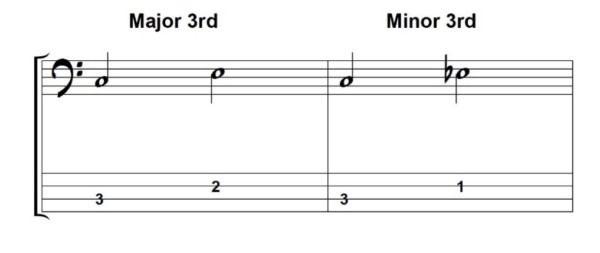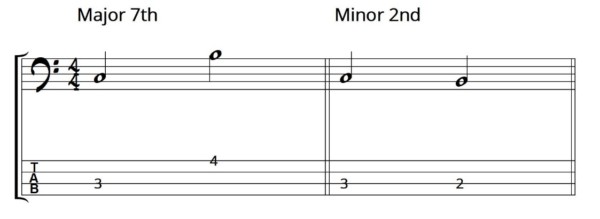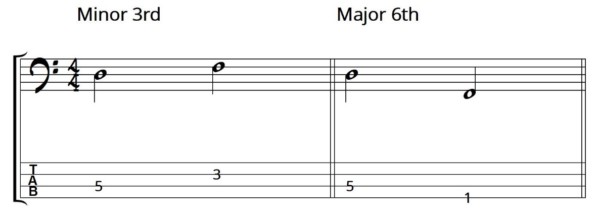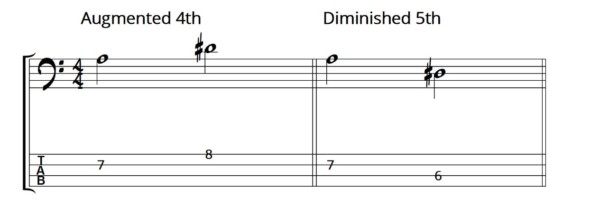In this lesson I’ll be looking to explain everything you’ll ever need to know about intervals in less than 15 minutes. We’ll look at the basic set of intervals derived from the major scale, minor intervals, augmented and diminished intervals, compound intervals and inverted intervals.
Interval Basics
First let’s lay out three basic points regarding intervals:
- Intervals are measurements of musical distance like tones and semitones (whole steps and half steps). Intervals are simply a little more descriptive.
- Interval names are unrelated to scales. The basic set of intervals are roughly named according to the major scale but, beyond that, ignore any relationship to scales.
- Intervals are basically the alphabet of music. They are the letters of the language. Musical phrases, scales, chords, arpeggios and everything else can be described and built from intervals.
Intervals Of The Major Scale
The most common set of intervals are based on a major scale. Below we see a simple C Major Scale:

We can then number the notes of the scale:

Intervals also contain a quality. The intervals of the major scale contain the following qualities:

Simply follow the principles:
- 1st, 4th and 5th are all Perfect Intervals
- All the rest are Major
Minor Intervals
To create a Minor Interval we simply take a Major Interval and drop the top note by a half step.
Here we see that from a root note of C, a Major 3rd is E and a Minor 3rd is Eb:

We can apply this principle to every Major interval and create Minor 2nd, Minor 3rd, Minor 6th and Minor 7th intervals:

Minor Intervals tend to sound darker or ‘sadder’. By listening out for the Emotive Quality of each interval we can develop our musicianship, ear and musical vocabulary.
Augmented & Diminished Intervals
We generally create Augmented and Diminished intervals by raising or lowering the Perfect Intervals by a half step.
- An Augmented Interval is created by raising the top note of a Perfect interval by a half step
- A Diminished Interval is created by lowering the top note of a Perfect interval by a half step
Here we can see these intervals applied to the 5th:

Here we can see these intervals applied to the 4th:

Enharmonic Equivalency
With a lot of augmented and diminished intervals we can find ourselves using the same pitch but with a different note name.
For example, the Diminished 4th from C is Fb. This could also be written as C to E. However, if we look at the notes alphabetically:
- D is the 2nd note from C
- E is the 3rd note from C
- F is the 4th note from C etc.
Therefore, C to E is always a 3rd of some kind. C to F is always a 4th of some kind, regardless of the sharps or flats involved.
For this reason, C to Fb is a Diminished 4th and C to E is a Major 3rd. They are the same pitch and fret on the bass but the interval name is different because of their alphabetic placement.
This principle of ‘same pitch – different note name’ is called Enharmonic Equivalency.
More Augmented/Diminished Intervals!
As well as augmented and diminished intervals on the 1st, 4th and 5th we can also have augmented and diminished 2nd, 3rd, 6th and 7th intervals! These are much less common but still an important part of music theory.
The augmented and diminished intervals lie above the major and below the minor:
- An Augmented Interval is created by raising the top note of a Major interval by a half step
- A Diminished Interval is created by lowering the top note of a Minor interval by a half step
Below are some examples of these intervals:
On a root note of A we could have the following 6th intervals:

- A to F#: Major 6th
- A to F##: Augmented 6th
- A to F: Minor 6th
- A to Fb: Diminished 6th
On a root note of D we could have the following 7th intervals:

- D to C#: Major 7th
- D to C##: Augmented 7th
- D to C: Minor 7th
- D to Cb: Diminished 7th
Beyond The Octave: Compound Intervals
So far, we’ve only looked at intervals within an octave. But we can also move to infinity and beyond by looking at Compound Intervals.
These are intervals beyond the octave and are easy to understand because they’re exactly the same as the intervals we’ve already covered but they just have a higher number.
The Octave is an interval in its own right: the perfect 8th.
Beyond the 8th we can continue our set of intervals as the 9th, 10th, 11th, 12th, 13th, 14th and the 15th as the second octave.
These intervals correspond to the intervals in our first octave:
- 9th = 2nd
- 10th = 3rd
- 11th = 4th
- 12th = 5th
- 13th = 6th
- 14th = 7th
- 15th = 8th (octave)
By applying the interval quality, we can see the set of intervals within the major scale as:
- Perfect 8th (Octave)
- Major 9th
- Major 10th
- Perfect 11th
- Perfect 12th
- Major 13th
- Major 14th
- Perfect 15th
The compound intervals in the second octave can be seen below from a C note. Remember, there are many different fingerings for any one interval. These are just an example:

These intervals can also be labelled by simply inserting the prefix ‘compound’. For example, the Major 9th may be written as Compound Major 2nd or the Perfect 11th would be the Compound Perfect 4th.
Interval Inversion
Lastly, we need to look at interval inversion. When we invert intervals we are basically measuring them in a downward direction. As an example:
- C up to B is a Major 7th
- C down to B is a Minor 2nd

This is interval inversion. We measure the same two notes but in the opposite direction.
The rules for interval inversion are as follows:.
- 2nd becomes 7th
- 3rd becomes 6th
- 4th becomes 5th
And vice versa:
- 7th becomes 2nd
- 6th becomes 3rd
- 5th becomes 4th
For the qualities:
- Perfect Intervals stay the same
- Major Intervals become Minor (and vice versa)
- Augmented Intervals become Diminished (and vice versa)
Here are some examples:
- C to G ascending is a Perfect 5th
- C to G descending is a Perfect 4th

- D to F ascending is a Minor 3rd
- D to F descending is a Major 6th

- A to D# ascending is an Augmented 4th
- A to D# descending is a Diminished 5th














Just typo on Interval Inversion…”C down to B is a Major 2nd”. Correctly underneath, “minor 2nd”.
Thanks for the lesson it makes sense when applied to the bass than just the theory alone. Excellent